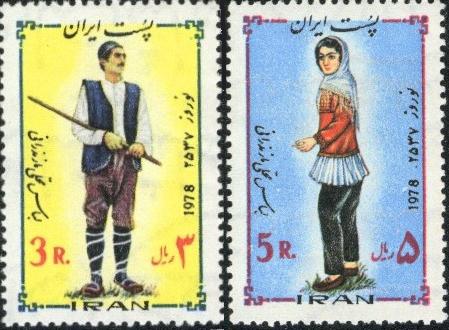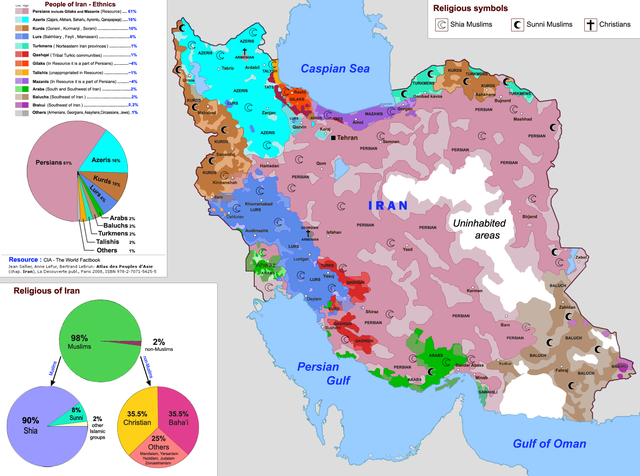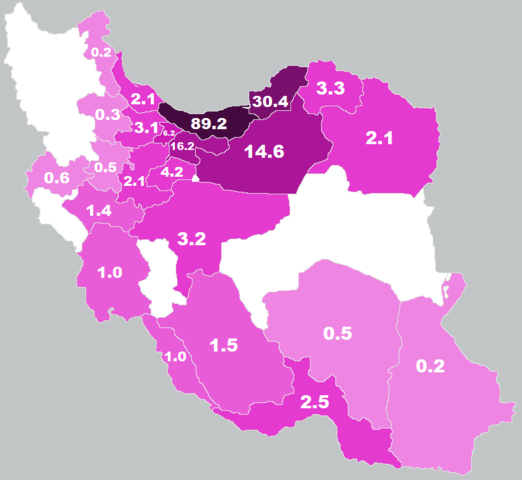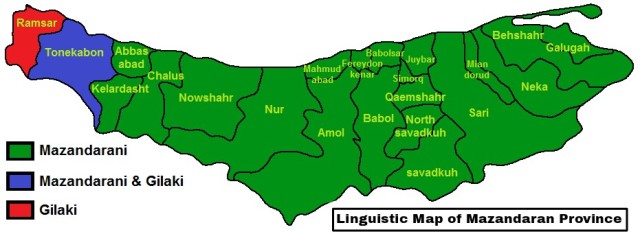MAZANDERANIS
PEOPLE

Traditional
clothing of Mazandaran people on Iranian stamps (1978)
The
Mazanderani people or Tabari people are an Iranian people who are
indigenous to the Caspian region of Iran. They are also referred
to as Mazanis for short. They inhabit the sea's south coast and
are part of the historical region known as Tabaristan. The Alborz
mountains mark the southern boundary of Mazanderani people's settlement.
People
:

Mazandaris
in Iran (dark purple)
The Mazanderani number between three and four million (2006 estimate).
Their dominant religion is Shiite Islam.
Most
Mazanderanis live on the south-eastern coast of the Caspian Sea.
Their traditional professions are farming and fishing. The Mazanderanis
are closely related to the neighbouring Gilaki people as well as
Caucasian peoples (e.g., the Georgians, Armenians, and Azerbaijanis).
Language
:

Mazandaranis in Iran
The Mazanderani language is a Northwestern Iranian language spoken
by the Mazanderani people; however, most Mazanderanis are also fluent
in Persian. The Gilaki and Mazanderani languages (but not other
Iranian languages) share certain typological features with Caucasian
languages.
With
the growth of education and the media, the distinction between Mazanderani
and other Iranian languages is likely to disappear. Mazanderani
is closely related to Gilaki and the two languages have similar
vocabularies. They preserve more of the noun declension system characteristic
of older Iranian languages than Persian does.
Assistant
professor Maryam Borjian of Rutgers University states that Mazanderani
has different sub-dialects and there is high mutual intelligibility
among Mazanderani sub-dialects.
Genetics
:

Linguistic
Map of Mazandaran Province
The Mazanderani and the closely related Gilaks occupy the south
Caspian region of Iran and speak languages belonging to the North-Western
branch of Iranian languages. It has been suggested that their ancestors
came from the Caucasus region, perhaps displacing an earlier group
in the South Caspian. Linguistic evidence supports this scenario,
in that the Gilaki and Mazanderani languages (but not other Iranian
languages) share certain typological features with Caucasian languages.
Based
on mtDNA HV1 sequences, the Gilaki and Mazanderani most closely
resemble their geographic and linguistic neighbors, namely other
Iranian groups. However, their Y chromosome types most closely resemble
those found in groups from the South Caucasus. Researchers explained
these differences that males from the Caucasus settled in the south
Caspian area, mated with women from local Iranian groups, possibly
because of patrilocality. The Mazanderani and Gilaki groups are
closely related on the male side with populations from the South
Caucasus such as Georgians, Armenians, and Azerbaijani's.
Haplogroups
:
Analysis of their NRY patrilines has revealed haplogroup J2, associated
with the neolithic diffusion of agriculturalists from the Near East,
to be the predominant Y-DNA lineage among the Mazanderani (subclades
J2a3h-M530, J2a3b-M67 and J2a-M410, more specifically.). The next
most frequently occurring lineage, R1a1a, believed to have been
associated with early Iranian expansion into Central/Southern Eurasia
and currently ubiquitous in that area, is found in almost 25%. This
haplogroup, with the aforementioned J2, accounts for over 50% of
the entire sample. Haplogroup G2a3b, attaining significant frequency
together with G2a and G1, is the most commonly carried marker in
the G group among Mazanderani men. The lineages E1b1b1a1a-M34 and
C5-M356 comprise the remainder, of less than 10% sampled.
Notable
figures :
Historic :
• Abu Jafar Muhammad ibn Jarir ibn Yazid
ibn Kathir al-Tabari (838–923) was a Mazanderani historian
and theologian (the most famous and widely influential person called
al-Tabari).
• Abu Jafar Muhammad ibn Jarir ibn Rustom
al-Tabari was a Shia thinker who is commonly confused with the former.
He is the author of the book Dala'il al-Imamah (Proofs of the Imamate)
• Ali ibn Sahl Rabban al-Tabari, "Ali
the scholar from Tabiristan" (838–870 A.D.), was the
writer of a medical encyclopedia and the teacher of the scholar
physician Zakariya al-Razi.
• Abul Hasan al-Tabari, a 10th-century Iranian
physician
• Al-Tabarani (c. 821–918 CE), author
of numerous ahadeeth
• Amir Pazevari, poet
• Maziar, Iranian aristocrat of the House
of Karen
Contemporary :
• Reza Shah, emperor of Iran (Persia) from
1924 to 1941
• Nima Yooshij, poet, 1941
• Mina Assadi, poet
• Emamali Habibi, Olympic and world champion of free-style
wrestling/Babr e Mazandaran
• Ali Larijani, former member of the Supreme National
Security Council of Iran and Speaker of the Majlis of Iran
• Mohammad Javad Larijani, mathematician and former
member of the Majlis
• Sadegh Larijani, head of the judiciary of the Islamic
Republic of Iran
• Mohammad Zohari, poet
• Mohsen Bengar, footballer
• Delkash, singer
• Ahmad Mohsenpour, musician
• Ali Pahlavan, singer
• Gholam-Hossein Banan, singer
• Ehsan Tabari, Marxist theoretician
• Noureddin Kianouri, politician
• Parinaz Izadyar, Actress
• Parviz Natel-Khanlari, writer/translator
• Habibollah Badiei, musician
• Reza Allamehzadeh, director
• Rashid Mostaghim, singer
• Behdad Salimikordasiabi, Olympic weightlifter
• Mohammad Donyavi, musician
• Emad Ram, musician
• Abdollah Movahed, Freestyle Wrestler - Olympics
Champion
Assimilated populations in Mazandaran :
In the Safavid, Afsharid, and Qajar eras Mazandaran was settled
by large amounts of Georgians, Circassians, Armenians and other
peoples of the Caucasus, whose descendants still live across Mazandaran.
Many towns, villages and neighbourhoods in Mazandaran bear the name
"Gorji" (i.e., Georgian) in them, although most of the
Georgians are assimilated into the mainstream Mazanderanis: they
keep a Georgian conscience. The history of Georgian settlement is
described by Iskandar Beg Munshi, the author of the 17th century
History of Alam Aray Abbasi. In addition foreigners, e.g., Chardin
and Della Valle, have written about their encounters with the Georgian,
Circassian and Armenian Mazanderanis.
Source
:
https://en.wikipedia.org/
wiki/Mazanderani_people




